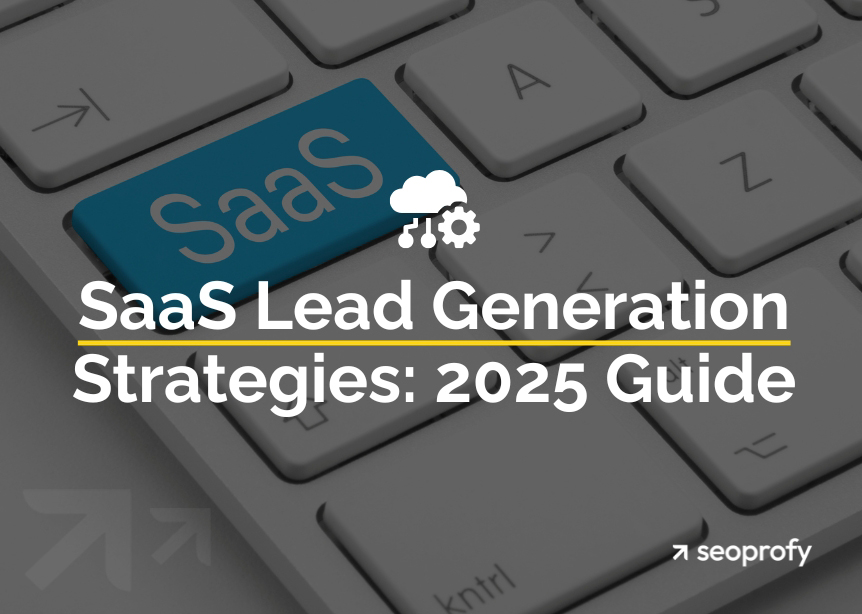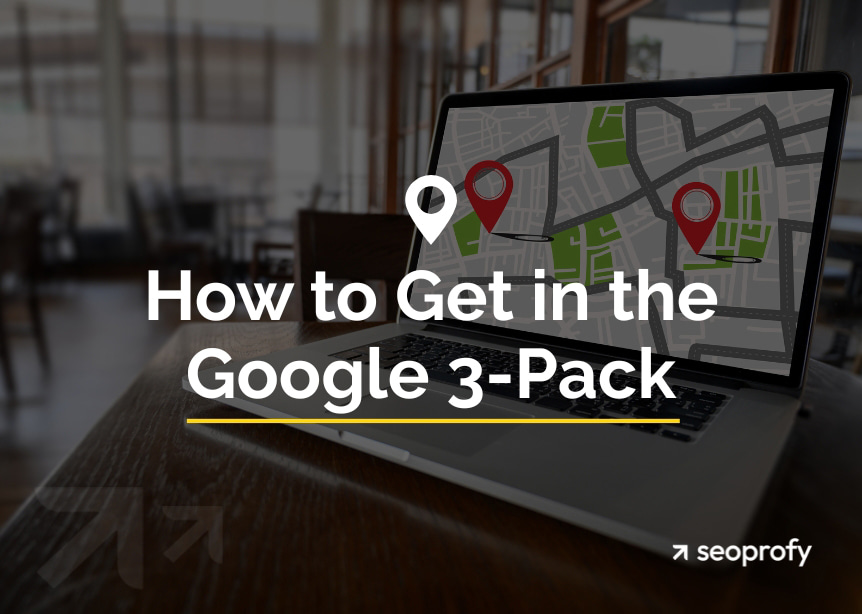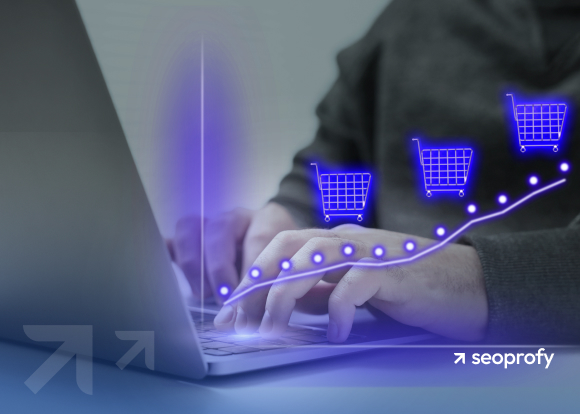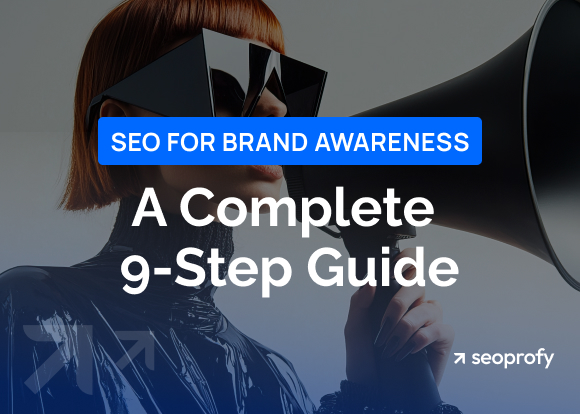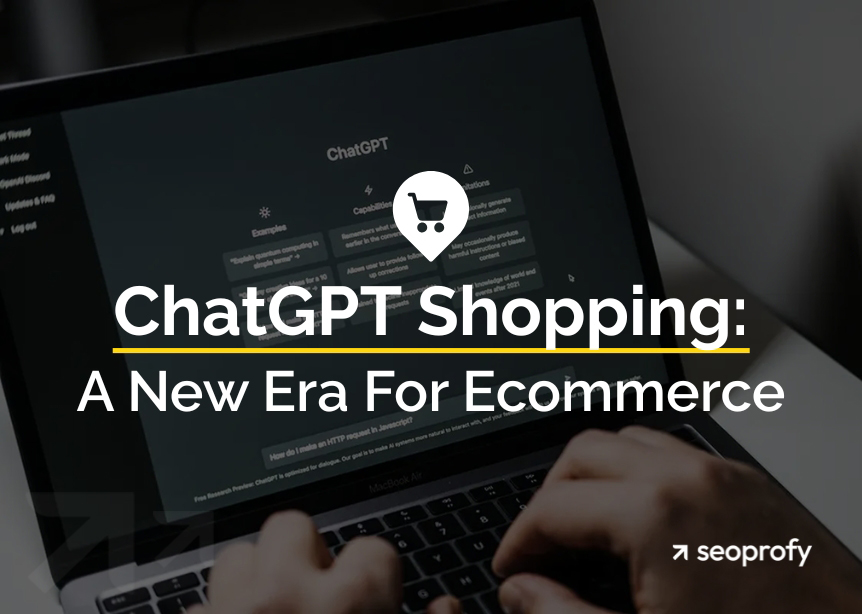Google Shopping SEO plays a crucial role in helping your products stand out in a competitive digital marketplace. By optimizing your listings with the right strategies, you can improve your visibility, attract high-intent shoppers, and ultimately increase conversions.
With the right approach to Google Product Search rankings and understanding Google Shopping ranking factors, your eCommerce store can unlock new growth opportunities. This guide will help you master the essentials, from setting up a Merchant Center account to advanced SEO techniques tailored to Google Shopping.
- Learn how to optimize product titles and descriptions for better rankings
- Discover strategies for using high-quality visuals and schema markup
- Understand the role of AI-driven features in improving rankings
- Master tracking and adjusting performance for continuous improvement
Introduction to SEO for Google Shopping
Search Engine Optimization (SEO) plays a pivotal role in enhancing product visibility on Google Shopping, a platform where potential buyers actively search for products they intend to purchase. With proper optimization, your listings can achieve higher rankings, resulting in greater exposure and a higher likelihood of conversions. Google Shopping’s algorithm evaluates product data, relevance, and user experience, underscoring the need for a strategic SEO approach.
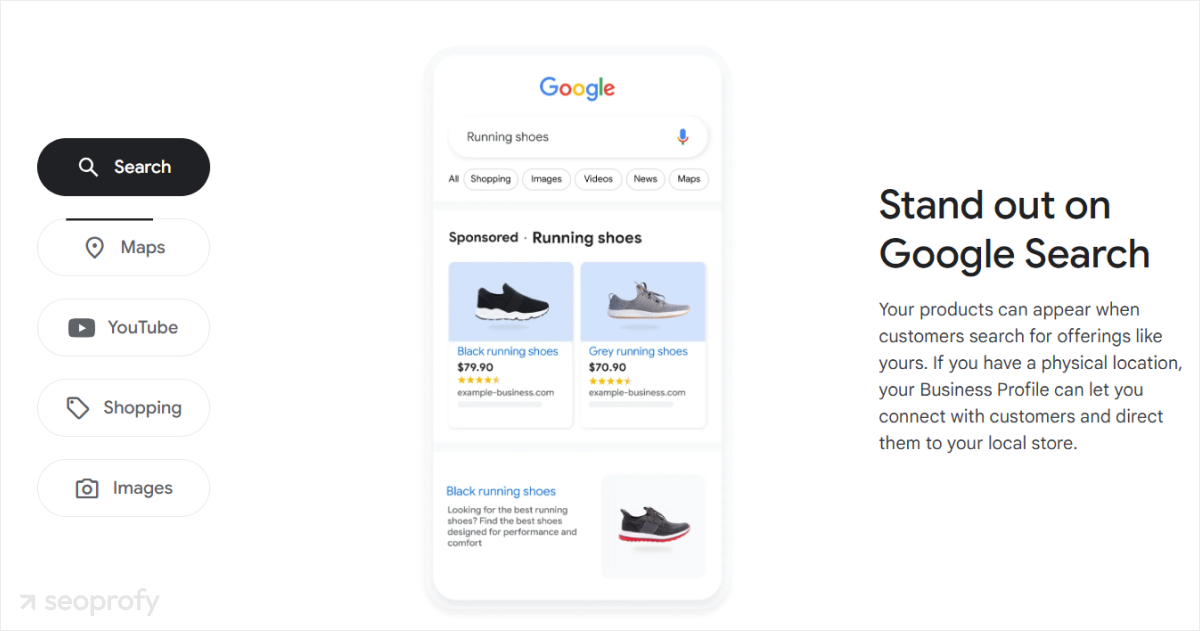
Google Shopping SEO ensures that your products appear in relevant search queries, leveraging the platform’s robust reach to connect with a targeted audience. Optimizing titles, descriptions, and product data not only aligns with Google’s ranking factors but also creates a seamless shopping experience for users. A well-executed SEO strategy can be the difference between standing out and being overlooked in this competitive space.
Why Google Shopping Matters for eCommerce
Google Shopping is a game-changer for eCommerce businesses, offering unmatched opportunities to boost visibility, drive traffic, and increase sales. By showcasing products directly in Google search results, it puts your offerings in front of shoppers who are ready to buy, making it an essential tool for reaching high-intent customers.
What sets Google Shopping apart is its ability to level the playing field. Smaller businesses can stand shoulder-to-shoulder with big retailers by using smart optimization strategies. Unlike traditional ads, Google Shopping focuses on shoppers who are already searching for specific products, resulting in higher conversion rates.
Take a small boutique selling handmade furniture as an example. With optimized listings using keywords like “handcrafted oak dining table,” the boutique can attract as much attention as larger competitors. This visibility not only drives traffic but also positions the boutique as a strong contender in its niche.
Beyond visibility, Google Shopping offers valuable data into consumer behavior, helping businesses fine-tune their strategies. By combining these insights with both free and paid listings, it becomes a vital component for eCommerce success in today’s competitive market.
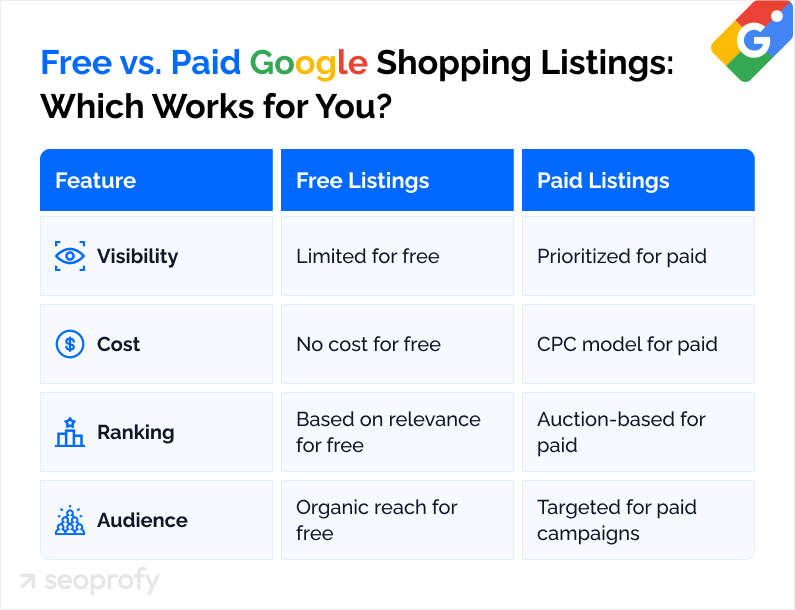
The Role of SEO in Google Shopping Success
Getting ranked on Google’s regular search results takes solid SEO, but at least Google can automatically find and index your site. However, if you want to appear on Google Shopping, there’s no chance unless you take a mandatory step — create a Google Merchant Center account. And it’s just the beginning.
Your product visibility “lives or dies” based on its relevance to searches. Google displays items by aligning them with current search terms, so your product titles, descriptions, and other information need to match what real people are looking for.
So, besides just creating an account, you should do comprehensive Google Shopping SEO with optimizations from A to Z. Here are some examples:
- Keyword research and placement in titles and descriptions
- Proper schema markup implementation
- Product feed optimization for mobile Google searches
- Clear shipping information
- Accurate product availability status
- Easy-to-find contact details
- Management of customer reviews and ratings
By keeping everything accurate and up-to-date, you’re showing Google you run a serious, trustworthy store and receive a higher probability of being listed at the top.
Plus, you’re not the only player in the market. Other eCommerce sites also have optimized lists. If you stay still with SEO, you’ll most likely lose ground to competitors.
Let’s make sure your audience does find you with powerful eCommerce SEO. Our SEO experts know exactly what it takes to get your products seen and sold. We’ll help you:
- Optimize product listings for maximum visibility
- Stay ahead of algorithm changes
- Turn browsers into buyers
- Track and improve your performance

Key Benefits of Optimizing for Google Shopping
But if you continue with optimization, you can expect the following benefits:
- Increased visibility: Optimized listings have a higher chance of appearing in both organic and paid shopping results, making your products more accessible to potential buyers.
- Improved Click-Through Rates (CTR): High-quality, keyword-optimized titles and descriptions naturally attract more users, leading to a significant increase in CTR.
- Higher conversion rates: Accurate product details, engaging descriptions, and appealing visuals create a seamless shopping experience, boosting conversions.
- Cost efficiency: Leveraging free listings reduces dependency on paid advertising while maintaining strong visibility across Google shopping search results.
- Competitive edge: Small businesses can compete effectively with larger retailers by optimizing their listings for Google Shopping’s unique algorithms.
Ready to reap these benefits? Let’s start your journey to total product visibility!
Set Up Your Google Shopping Account
First things first, you need a Merchant Center account. In this section, we’ll describe two basic steps: account creation and store linking.
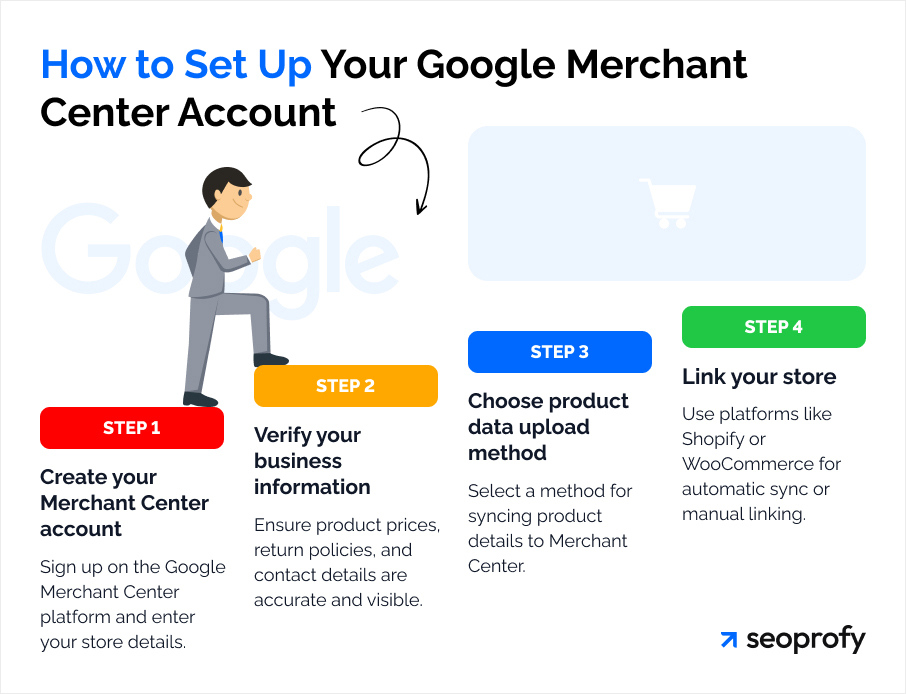
Create and Verify Your Google Merchant Center Account
Go to the Google Merchant Center sign-up page and share your store details: selling online or have a physical store?
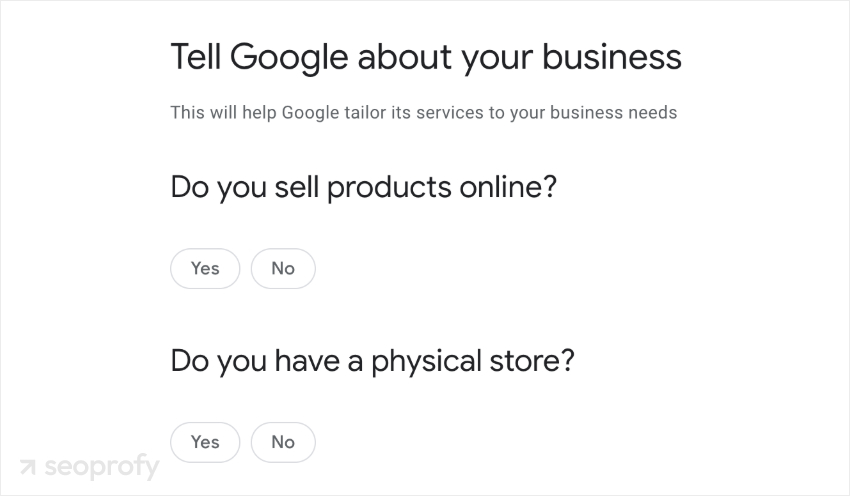
Your online store needs to meet some requirements. Whether you run your own eCommerce site or use platforms like Shopify or WooCommerce, here’s what must be clearly visible:
- Clear product prices
- A simple way for customers to return items
- Safe payment options
- Easy-to-find contact details
Next, enter your official business name and select your business’s registered location from the drop-down menu. The Merchant Center will automatically set your time zone based on the country or region you enter in your business address. If you need to change your country later, you can update this at any time.
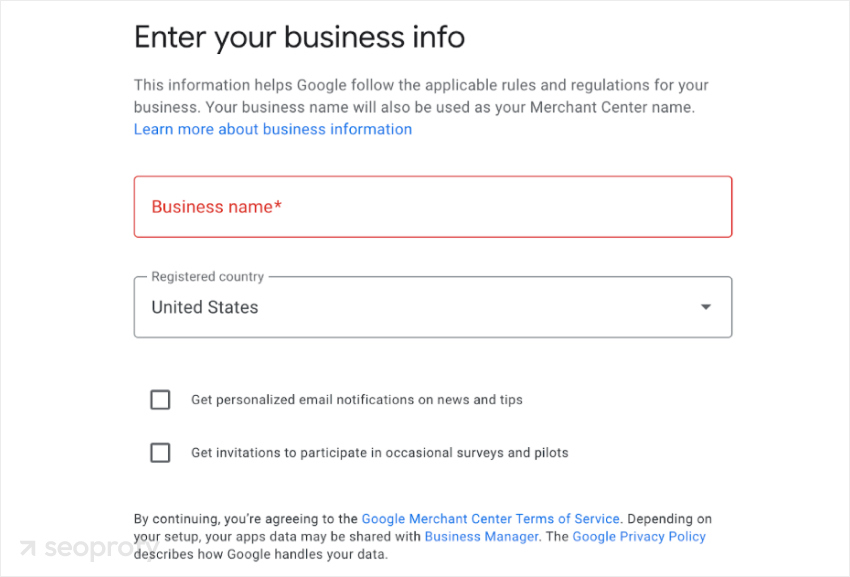
After, you’ll need to set up how your product information enters the Merchant Center. There’s a lot of flexibility — Google provides a few options to share your product details. It can automatically pull product data from your online store so that your prices, descriptions, and images can sync right away.
If automatic sync isn’t the best fit, Google will help you pick another method that works for your business.
Link Your Store and Ensure Data Accuracy
Only super admins in the Merchant Center can add new stores. If you want to know who your super admin is, you can find them in Business Manager under “People and access.” They can connect the accounts for you or make you a super admin if needed. Here’s how to add your store:
- Find the Settings & Tools icon on the top right side of the Merchant Center. Look for the gear icon. Click it and choose “Apps and Services.”
- Under the section called “Google Services,” you’ll see an “Add service” button. Click it, then select “Google Business Profile.”
- Now you’ll see a list of your stores. Pick the ones you want to connect to Merchant Center and click “Next.”
If you’re using platforms like Shopify or WooCommerce, Google Merchant Center can connect directly to these platforms. And even with automatic sync, you can modify product details and add more products to the listing.
You can also take advantage of the Content API for Shopping, which simplifies the management of large or complex Merchant Center accounts.
Core Elements of Google Shopping Optimization
You’ve set up your Merchant Center account and linked your store. Awesome! Let us follow you through the rest of the steps to make your products simple to find and impossible to ignore.
Optimize Product Titles and Descriptions
Google Shopping product title optimization should start with the essentials: brand name, model, and main features. As the saying goes, clear beats clever, so focus on straightforward wording, and this relates to descriptions, too.
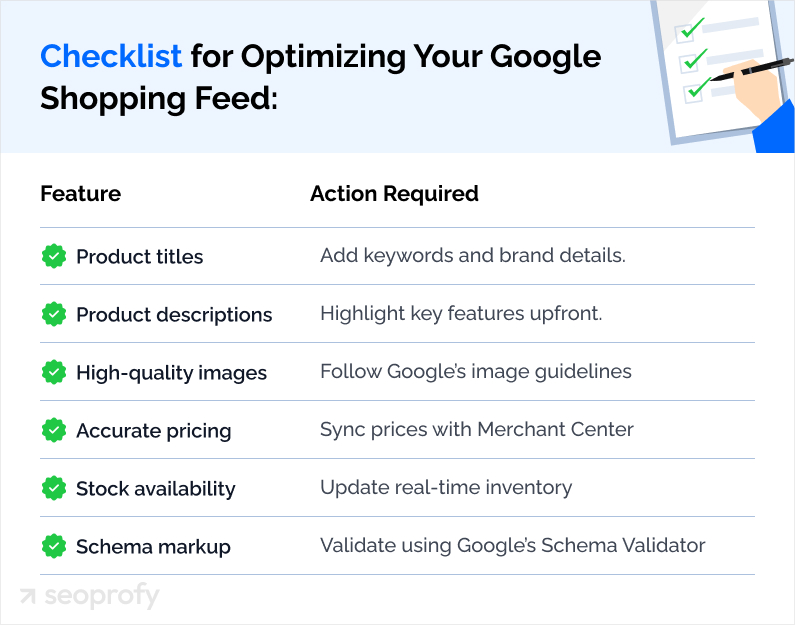
Just make sure to incorporate relevant keywords since they help search engines understand what you sell and let you appear at the right moment. To find the right keywords, do a bit of research:
- Check your own data: The terms customers use to find products on your site. They can be beneficial for your Google Shopping tab listings.
- Analyze competitors: Examine successful online retailers in your product category and take note of the words they’re using in their top organic product listings.
- Use Google Shopping’s search box: Type the beginning of product searches and see what Google auto-suggests. These suggestions reveal actual terms shoppers often use.
- Use Google’s Keyword Planner: It’s free and shows exactly what terms people use when they do shopping. You’ll also see how many people use these specific search queries.
And always keep in mind that mobile users see less text, so be sure to put key information at the beginning.
Check out our detailed SEO guide for e-commerce, which further explains how to improve search rankings.
Leverage High-Quality Images
Google has specific image guidelines to ensure all product images maintain high standards. It establishes minimum image sizes based on the type of product: non-apparel products: 100 x 100 pixels, and apparel products: 250 x 250 pixels.
No image should be larger than 64 megapixels or 16 MB in size.
If you sell packaged products, showcase more than just the front view but include different angles so that customers can fully understand what they’re going to buy. And if it’s a bundle, all the items must be visible in the image.
Overall, Google prefers clean and straightforward product photos. This means avoiding advertising text or slogans, price tags, borders, and logos.
Using Videos to Enhance Listings
Videos can also be a powerful tool for showcasing product features, explaining usage, or highlighting unique selling points. A 30- to 60-second clip demonstrating the product in action can significantly increase user engagement.
Tips for effective product videos:
- Focus on key features: Highlight what sets your product apart, such as durability, versatility, or ease of use.
- Professional production: Ensure clear visuals, good lighting, and a steady camera.
- Call-to-Action: Include a subtle CTA, such as “Buy now” or “Explore more details.”
By leveraging high-quality images and videos, you not only improve your Google Shopping rankings but also create a more compelling experience that encourages shoppers to click, explore, and purchase.
Structure Product Data with Schema Markup
When you add a product to your website, people can easily understand what it is just by looking at the page. They can see the price, a description, whether it’s in stock, and any reviews. But search engines like Google need a little more help to get the full picture.
That’s exactly why schema markup is needed — it’s a special code you should add to your website’s code to label each piece of information for Google. For instance, if you display $99.99 on your page, schema markup informs Google that this is a price.
Without schema markup, Google could misunderstand your product information or totally miss crucial details, which can make your products harder to find in search engine results.
The best type of structured data format is JSON-LD, as it works well for Google Shopping. To add it to your website, you need either direct access to your website’s HTML code or permission to modify your online store’s template settings (if you’re using an e-commerce platform like Shopify or WooCommerce).
Before you hit the go-live button, make sure to validate your schema markup using Google’s Reach Results Test or Schema Markup Validator. These tools will let you detect any errors before they can affect your visibility.
Advanced SEO Strategies for Google Shopping
While we’ve already discussed crucial optimization steps, Google Shopping has more nuances. There’s a whole world of strategies that can put your products front and center.
Keep Up with Google’s AI Upgrades
AI is everywhere these days, and Google Shopping is no different. Google has recently rolled out exciting AI features that make shopping experiences much smarter for buyers yet create the need for eCommerce retailers to adapt.
AI is now able to generate quick summaries of the key aspects of a purchase. For example, when searching for a winter jacket, shoppers will get:
- Key features to consider for their specific needs
- Recommended products with explanations of why they fit
- Organized categories to simplify comparison
- Relevant articles for deeper research
- Smart filters that understand your preferences
In addition, AI can help discover the best offers by:
- Comparing prices across stores
- Tracking price changes
- Highlighting personalized deals
This AI update makes the previously discussed listing optimization steps even more important. Detailed descriptions, competitive pricing, relevant stock status, and clean schema markup all matter since AI feeds on them to provide relevant Google Shopping organic results.
Adapt to Updated Product Specifications
Aside from AI-related upgrades, Google constantly introduces other critical updates. You can’t ignore what affects Google Shopping ranking factors since your visibility in Google Shopping depends on them.
For example, look at the 2024 Merchant Center product data specification update.
From now on, if you’re using AI tools to create product descriptions, titles, or other content, you need to specify that clearly in your product data.
Additionally, Google has launched a new loyalty program attribute for the US and Japanese markets. This lets you showcase member prices, loyalty points, and special shipping benefits. Add this attribute, and your potential customers will be able to understand the full value of shopping with your loyalty program.
Plus, there was an update on installment-based offers. The key change is how installment payments are presented. Google now categorizes products with installment plans as having two payment options, like full payment upfront or payment in installments.
An important new feature is the downpayment sub-attribute, which lets online retailers specify if an initial payment is necessary for a product. This information previously had to be mentioned within the regular price attribute, which could lead to confusion.
Google has also launched a new attribute to clarify when free shipping applies. It’s available worldwide and allows sellers to indicate the exact order value needed to qualify for free delivery.
When Google announces new requirements, make sure to implement these changes promptly. As soon as you see any new rules, take a look at what’s changing and see if it affects Google Shopping rankings. After all, just a little bit of time with disapproved organic listings or lower visibility can mean missed sales.
Do Mobile and Local SEO
People often use mobile phones to do shopping and search for products in nearby stores. That’s another aspect that can’t be overlooked in your organic Google Shopping strategy.
Let’s start with mobile optimization. Your product titles need to be clear and front-loaded with important information since mobile screens fit less text. Google images must look sharp on small screens and load quickly to keep shoppers engaged.
And don’t forget about local SEO. By enabling local inventory features, you let your customers find out if products are in stock at stores close to them.
Overall, the main local features include accurate store location details, up-to-date information on local stock availability, store-specific pricing, options for local store pickup, and special in-store promotions.
This will let shoppers easily check what’s available locally, compare prices, and even reserve items for pickup.
Track and Improve Performance
What gets measured gets improved, but the true skill is about identifying what to measure and how to convert those numbers into tangible results. Here’s how you can do this.
Monitor Metrics with Google Merchant Center
You can access all your key metrics directly in your Google Merchant Center account. Just head to the Analytics section, click on “Online Store,” and here’s how you can access your listing performance across three core metrics:
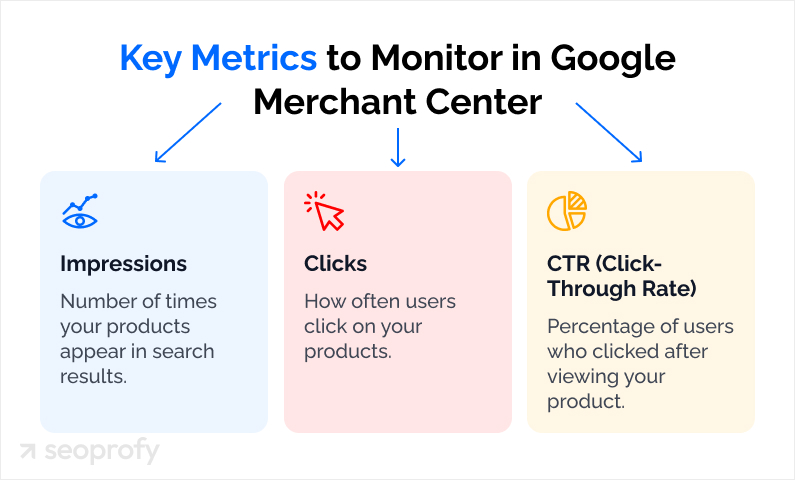
- Clicks show how many shoppers were interested enough to tap on your products.
- Impressions tell you how many times Google has shown your products to buyers.
- The click-through rate (CTR) is the percentage of people who actually clicked after seeing your products. To get this number, divide clicks by impressions and multiply by 100. This gives you an idea of how catchy your listings are to shoppers.
Adjust Listings Based on Performance Data
Once you’ve got those numbers in your hands, you can understand whether your results are satisfactory and, if not, determine what needs fixing in your organic listings.
For instance, if you notice a product with low clicks, this may mean that the best features are hidden at the end of your product description. In this case, you can update low-performing product data with enticing keywords at the beginning.
If you’re getting low impressions, it can be a sign of some bigger problems — Google might not trust your listings enough to show them often or just doesn’t understand what your offering is about.
In this situation, take another look at your product titles and descriptions from a search perspective. You could try to include specific, commonly searched terms that accurately describe your products.
Yes, optimization can be complex sometimes, given so many Google Shopping ranking factors as well as external factors, like the SEO efforts of your rivals. Just changing the order of details in the title can transform how shoppers react to your listings.
This creates the need for continuous testing so you can always learn something new about your customer preferences and the approach of Google to rankings. So keep experimenting and stay curious!
If you find yourself overwhelmed with the details, consider consulting with an e-commerce SEO company with expertise in organic Google Shopping searches.
Future Trends in Google Shopping
Just like everything else, Google Shopping is changing fast. Let’s look at what will be important to pay attention to in the near future.
AI’s Growing Role in eCommerce Rankings
Right now, Google Shopping AI features are undergoing initial testing phases. Google carefully releases each update and modifies it based on actual customer feedback.
So, if you plan to invest in your organic Google Shopping strategy, consider the role of AI in Google’s ranking decisions in the first place. AI is already here, and it watches what customers click, buy, and ignore. It learns their shopping habits and price preferences. Then, it uses this data to rank products in a way that matches what shoppers want.
Thus, without understanding how AI works, you might miss out on key ranking factors that AI considers important and simply waste time on outdated optimization tactics.
Prepare for Algorithm Updates
Google frequently upgrades its algorithms. For instance, at the time of writing, the recent update was introduced in August 2024.
Each change can impact Google Shopping rankings in the blink of an eye; that’s why it’s so crucial to stay updated on these events. Their main goal never changes — Google wants to provide a better shopping experience. If you’re following honest SEO tactics and not trying any manipulative shortcuts to boost your rankings fast, you should be good.
Yet, if you still notice a decrease in rankings, you have to understand the reason for it and quickly adopt a new approach. During algorithm shifts, it might be smart to set aside some budget for Google shopping ads to keep your visibility during these algorithm changes.
Conclusion
Once you understand how to rank in Google Shopping, your products will start appearing in front of the right customers, and you’ll begin to differentiate yourself from your competitors and get more sales. The most exciting part is that this traffic is free. All you need is to achieve that peak once and then maintain your rankings.
The marketplace is getting more competitive every day, but the principles of effective optimization still provide you with a significant edge. SeoProfy is here to enhance that edge. Let’s discuss how to translate these strategies into tangible outcomes for your store!



